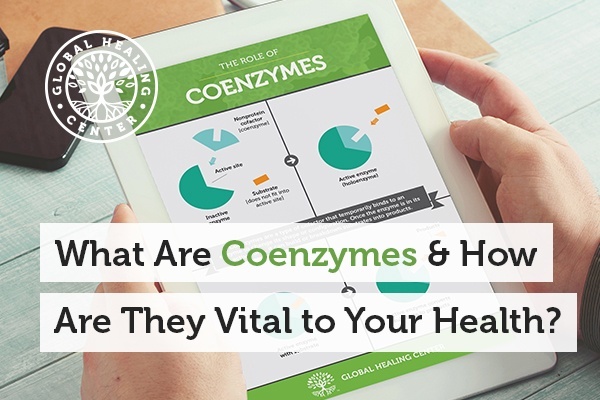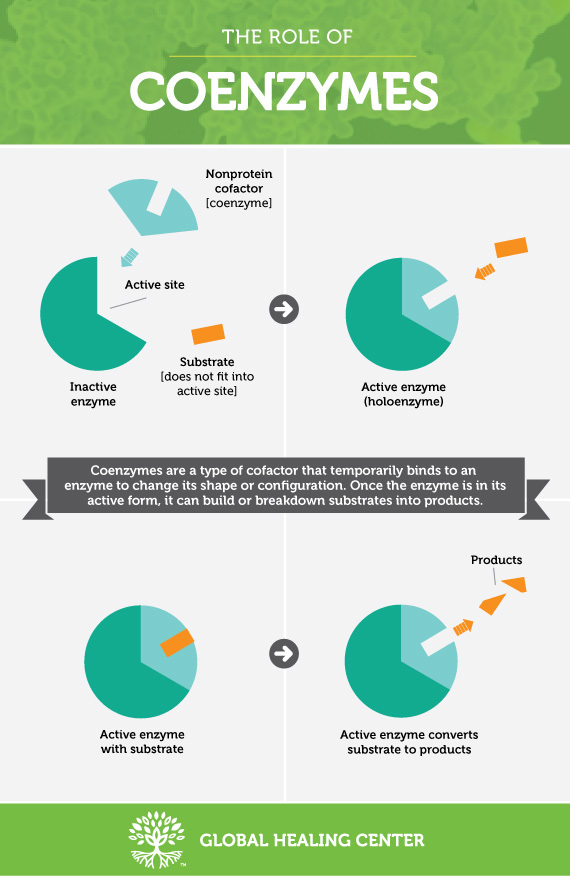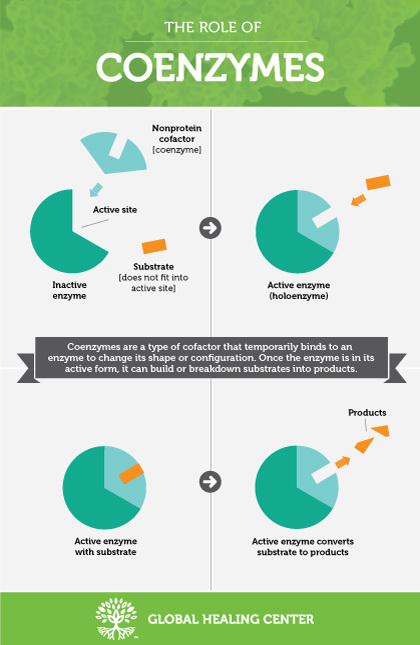
Coenzymes are required in many enzymatic and metabolic processes in your body, in plants, and in animals. Without coenzymes, inactive enzymes would be unable to convert into their active forms to catalyze reactions, such as breaking down food for energy. Coenzymes are essential for normal and specialized cellular functions and your overall health. One of the reasons vitamins are so integral to your health is because many coenzymes are synthesized using vitamins. Some of the more well-known coenzymes you may have heard of include coenzyme Q-10 (CoQ) and coenzyme A (CoA).
What Are Coenzymes?
Coenzymes, sometimes called cosubstrates, are organic nonprotein cofactors that help enzymes drive chemical reactions in the body. Coenzymes are not enzymes — they are simply small molecules that loosely attach themselves to an inactive enzyme, called an apoenzyme. Not all enzymes require cofactors to perform their chemical reactions.
The relationship between coenzymes and enzymes is a bit like that between lock and key. The apoenzyme is the lock, and the coenzyme is the key. Only certain keys (coenzymes) will fit certain locks, the active site on apoenzymes in this metaphor. The unique fit of the active sites on apoenzymes ensures only the correct coenzymes will fit and work.


How Coenzymes Function
The temporary binding between coenzymes and their apoenzymes means coenzymes can easily detach themselves from the enzyme after a biochemical reaction occurs. These small organic cofactors can then take part in further enzymatic reactions.
The other type of cofactors, called prosthetic groups, work in much the same way as coenzymes. The main difference between coenzymes and prosthetic groups is that prosthetic groups are typically metal ions. These cofactors bind much more tightly, using covalent bonds, to their apoenzymes and, unlike coenzymes, cannot detach themselves easily from the enzyme. Once the cofactor, either the coenzyme or prosthetic group, and apoenzyme have formed a cofactor-enzyme complex, it becomes a holoenzyme. This is the active form of an enzyme.
But coenzymes do more than just help enzymes function. They can help transfer compounds between enzymes. This is often a successive process, with every enzyme reaction slightly modifying the original molecule along the enzyme pathway. Coenzymes also help attract the correct compounds and repel incorrect compounds to the active site of their enzyme. This is an important function of coenzymes because of a phenomenon called competitive inhibition.
In competitive inhibition, the wrong compound binds to an enzyme's active site, preventing the enzyme from carrying out its duty.[1] This mechanism helps control the actions of the enzyme when it's not needed.
Why Are Coenzymes Essential?
If you've ever wondered why certain conditions develop as a result of vitamin deficiencies, one answer is that some vitamins are converted into coenzymes. In the absence of those vitamins, some enzymes won't be able to perform their duties correctly or at all. This is why certain forms of vitamins are better than others and why some vitamins are considered metabolically inactive.
Coenzymes are largely responsible for the transfer of functional groups (active sections or arms of chemical compounds), electrons, hydrogens, and energy. Some even enhance the stability or reactivity of an enzyme's product.[2, 3]
| Coenzyme | Enzyme | Vitamin Precursor | Function |
|---|---|---|---|
| Methylcobalamin (B-12)[4] | Methionine synthase and others | B-12 | Transfers the methyl group[7] |
| NAD (Nicotinamide adenine dinucleotide)[5] | Malate Dehydrogenase, pyruvate dehydrogenase and others | B6[6] | Transfers electrons and hydrogen atoms[7] |
| FAD (Flavin adenine dinucleotide)[5] | D-lactate dehydrogenase and others | B2[6] | Transfers electrons and hydrogen atoms[7] |
| Coenzyme Q (ubiquinone)[5] | Cytochrome c - oxidoreductase ad others | B5[6] | Transfers electrons and hydrogen atoms[7] |
| Biotin[5] | Propionyl-CoA carboxylase and others | Biotin[6] | Carries carboxyl groups[8] |
How to Support Proper Enzymatic Function
When you're not properly nourished, your cells can't make the products or run essential processes they need to maintain your health. Many diseases and conditions can arise from nutritional deficiencies. Coenzymes function at the molecular level, but their importance resonates throughout the body. This is why coenzymes and their vitamin precursors are so important to your health. Moreover, it's essential to get the proper, active forms of these vitamins, which are found naturally in whole, plant foods. Peanuts, tree nuts, and beans are healthy vegan sources of these vital nutrients.
A notable exception is the most active form of vitamin B12. There are many inactive forms of B12, which are functionally useless to your enzymes. To ensure you get the correct cofactor form of vitamin B12, check the label for methylcobalamin. Your body uses this coenzyme to detoxify your tissues of excess homocysteine by converting it into methionine, an essential amino acid.[9] Adenosylcobalamin is another form of B12 that's vital to the metabolism of proteins and fats.[10] Because these two cobalamins are so important to vascular, brain, and metabolic health, we formulated our own Vitamin B12. This certified organic liquid contains methylcobalamin and adenosylcobalamin, but also contains hydroxocobalamin for long-lasting, sustained support with 5,000 mcg of B12 per serving.
References (10)
- "BIOCHEMISTRY."N.p., 2017. Web. 16 Mar. 2017.
- "What Is a Functional Group?" UCLA. N.p., 2017. Web. 16 Mar. 2017.
- "Vitamin C And Skin Health." Linus Pauling Institute. N.p., 2017. Web. 16 Mar. 2017.
- Gruber K, et al. "Vitamin B12-Derivatives-Enzyme Cofactors And Ligands Of Proteins And Nucleic Acids". N.p., 2017. Web. 16 Mar. 2017.
- "Coenzymes And Cofactors." N.p., 2017. Web. 16 Mar. 2017.
- Berg, Jeremy, John Tymoczko, and Lubert Stryer. "NAD+, FAD, And Coenzyme A Are Formed From ATP." N.p., 2017. Web. 16 Mar. 2017.
- Storey, K. B. "Functional Metabolism." 1st ed. Hoboken, N.J: Wiley-Liss, 2004. Print.
- "The Function Of Biotin." N.p., 2017. Web. 16 Mar. 2017.
- "Supplement Fact Sheet: Vitamin B12." National Institute of Health: Office Of Dietary Supplements. N.p., 2017. Web. 16 Mar. 2017.
- Gröber, Uwe, Klaus Kisters, and Joachim Schmidt. "Neuroenhancement with Vitamin B12—Underestimated Neurological Significance." Nutrients 2013, 5, 5031-5045. Web. 16 Mar 2017.
†Results may vary. Information and statements made are for education purposes and are not intended to replace the advice of your doctor. If you have a severe medical condition or health concern, see your physician.







